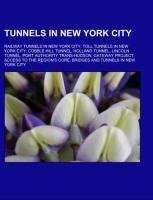
-
 Anglický jazyk
Anglický jazyk
Tunnels in New York City
Autor: Source: Wikipedia
Source: Wikipedia. Pages: 41. Chapters: Railway tunnels in New York City, Toll tunnels in New York City, Cobble Hill Tunnel, Holland Tunnel, Lincoln Tunnel, Port Authority Trans-Hudson, Gateway Project, Access to the Region's Core, Bridges and tunnels in... Viac o knihe
Na objednávku, dodanie 2-4 týždne
14.70 €
bežná cena: 16.70 €
O knihe
Source: Wikipedia. Pages: 41. Chapters: Railway tunnels in New York City, Toll tunnels in New York City, Cobble Hill Tunnel, Holland Tunnel, Lincoln Tunnel, Port Authority Trans-Hudson, Gateway Project, Access to the Region's Core, Bridges and tunnels in New York City, Cross-Harbor Rail Tunnel, New York Tunnel Extension, New York City water supply system, Uptown Hudson Tubes, North River Tunnels, Brooklyn-Battery Tunnel, New York City Water Tunnel No. 3, Freedom Tunnel, 63rd Street Tunnel, Queens-Midtown Tunnel, Montague Street Tunnel, Columbia University tunnels, East River Tunnels, Park Avenue Tunnel, Downtown Hudson Tubes, 60th Street Tunnel, Steinway Tunnel, Clark Street Tunnel, Joralemon Street Tunnel, Staten Island Tunnel, 178th-179th Street Tunnels, Battery Park Underpass, 14th Street Tunnel, Cranberry Street Tunnel, 53rd Street Tunnel, Rutgers Street Tunnel, 149th Street Tunnel, Lexington Avenue Tunnel, Concourse Tunnel. Excerpt: ) 33rd StreetThe Port Authority Trans-Hudson (PATH) is a rapid transit railroad linking Manhattan, New York with New Jersey, and providing service to Jersey City, Hoboken, Harrison, and Newark. It is operated by the Port Authority of New York and New Jersey. While some PATH stations are adjacent to New York City Subway, Newark Light Rail, Hudson-Bergen Light Rail, and New Jersey Transit stations, there are no free transfers between these different, independently run transit systems; however, PATH does accept the same pay-per-ride MetroCard used by the New York City Subway. PATH trains run 24 hours a day. PATH has a route length of 13.8 miles (22.2 km), not including any route overlap. PATH trains use tunnels only in Manhattan, Hoboken and downtown Jersey City. The tracks cross the Hudson River through century-old cast iron tubes that rest on the river bottom under a thin layer of silt. PATH's routes from Grove Street in Jersey City west to Newark run in open cuts, at grade level, and on elevated track. As of the 4th quarter of 2007, PATH had an average weekday ridership of 246,000. The history of PATH, originally known as the Hudson and Manhattan Railroad, predates the first underground line of the New York City Subway (the IRT). Although the railroad was first planned in 1874, existing technologies could not safely tunnel under the Hudson River. Construction began on the existing tunnels in 1890, but stopped shortly thereafter when funding ran out. Construction did not resume until 1900 under the direction of William Gibbs McAdoo, an ambitious young lawyer who had moved to New York from Chattanooga, Tennessee. McAdoo would later become president of what would, for many years, be known as the H&M, Hudson Tubes or McAdoo Tunnels. The first tunnel (the northernmost of the uptown pair) was originally built without an excavation shield or iron construction because the chief engineer of the time, Dewitt Haskin, believed that the river silt was strong enough to maintain
- Vydavateľstvo: Books LLC, Reference Series
- Rok vydania: 2012
- Formát: Paperback
- Rozmer: 246 x 189 mm
- Jazyk: Anglický jazyk
- ISBN: 9781156876114


 Nemecký jazyk
Nemecký jazyk 








